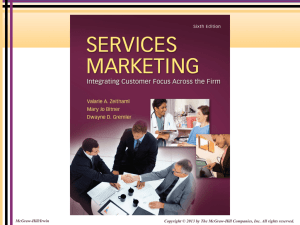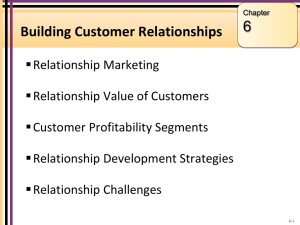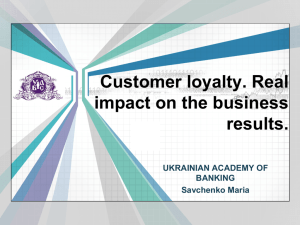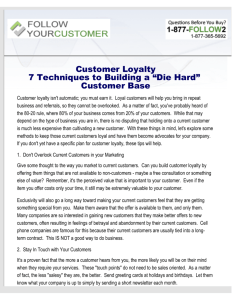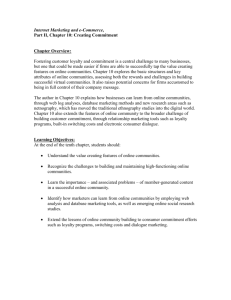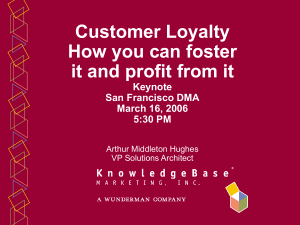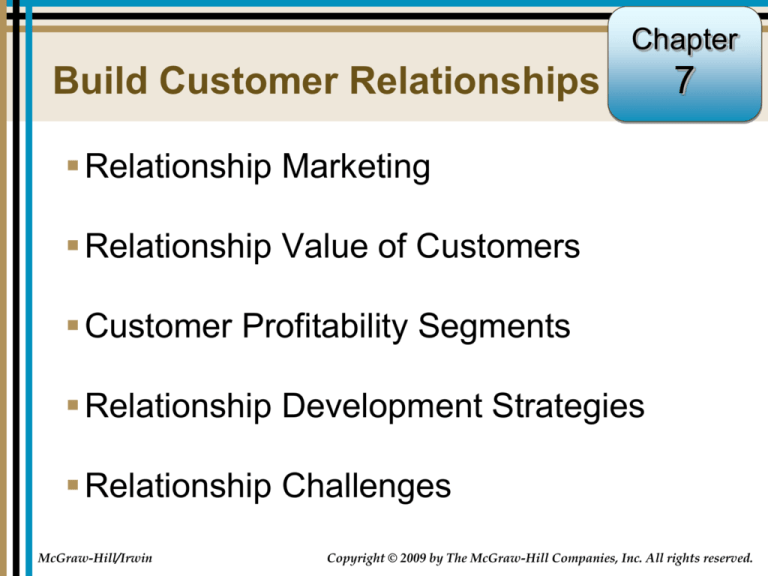
Chapter7-1
Build Customer Relationships
7
Relationship Marketing
Relationship Value of Customers
Customer Profitability Segments
Relationship Development Strategies
Relationship Challenges
McGraw-Hill/Irwin
Copyright © 2009 by The McGraw-Hill Companies, Inc. All rights reserved.
Objectives for Chapter 7:
Building Customer Relationships
Explain relationship marketing, its goals, and the benefits of
long-term relationships for firms and customers.
Explain why and how to estimate customer relationship value.
Introduce the concept of customer profitability segments as a
strategy for focusing relationship marketing efforts.
Present relationship development strategies—including quality
core service, switching barriers, and relationship bonds.
Identify challenges in relationship development, including the
somewhat controversial idea that “the customer is not always
right.”
7-2
7-3
Relationship Marketing
is a philosophy of doing business, a strategic orientation,
that focuses on keeping current customers and improving
relationships with them
does not necessarily emphasize acquiring new customers
is usually cheaper (for the firm)
keeping a current customer costs less than attracting a new one
thus, the focus is less on attraction, and more on retention
and enhancement of customer relationships
7-4
The “Bucket Theory of Marketing”
7-5
Customer Goals of Relationship Marketing
7-6
A Typology of Exchange Relationships
7-7
Benefits of Relationship Marketing
Benefits for Customers: Benefits for Firms:
Receipt of greater value
Confidence benefits:
trust
confidence in provider
reduced anxiety
Social benefits:
familiarity
social support
personal relationships
Special treatment benefits:
special deals
price breaks
Economic benefits:
increased revenues
reduced marketing and administrative
costs
regular revenue stream
Customer behavior benefits:
strong word-of-mouth endorsements
customer voluntary performance
social benefits to other customers
mentors to other customers
Human resource management
benefits:
easier jobs for employees
social benefits for employees
employee retention
7-8
Profit Generated by a Customer Over Time
Profit Impact of 5 Percent Increase in
Retention Rate
Source: F. F. Reichheld, “Loyalty and the Renaissance of Marketing,” Marketing Management, vol. 2, no. 4 (1994), p. 15.
7-9
7-10
Customer Loyalty Exercise
Think of a service provider to whom you are
loyal.
What do you do (your behaviors, actions,
feelings) that indicates you are loyal?
Why are you loyal to this provider?
What factors have influenced the formation
of your loyalty?
7-11
The Customer Pyramid
7-12
The Customer Pyramid
Platinum
Tier
Company’s most profitable customers, typically heavy users of
the product, not overly price sensitive, willing to invest in and try
new offerings, and committed customers of the firm
Gold Tier
Profitability levels are not as high, perhaps because customers
want price discounts that limit margins or are simply not as loyal.
May be heavy users who minimize risk by working with multiple
vendors.
Iron Tier
Essential customers that provide the volume needed to utilize the
firm'’ capacity but their spending levels, loyalty, and profitability
are not substantial enough for special treatment
Lead Tier
Customers who are costing the firm money. They demand more
attention than they are due given their spending and profitability
and are sometimes problem customers—complaining about the
firm to others and tying up firm resources.
Segmenting Customers Based on
Commitment and Profitability
(Behavioral Loyalty)
CLV
High
Low
BUTTERFLIES
TRUE FRIENDS
• Good fit of company offering and
customer needs
• High profit potential
• Action:
• Good fit of company offering and
customer needs
• Highest profit potential
• Actions:
–Aim to achieve transactional satisfaction, not
attitudinal loyalty
–Milk the accounts as long as they are active
–Key challenge: cease investment once
inflection point is reached
–Consistent intermittently spaced
communication
–Achieve attitudinal and behavioural loyalty
–Invest to nurture/defend/retain
STRANGERS
BARNACLES
• Little fit of company offering and
customer needs
• Lowest profit potential
• Action:
• Limited fit of company offering and
customer needs
• Low profit potential
• Action:
–No relationship investment
–Profitize every transaction
Low
–Measure size and share-of-wallet
–If share-of-wallet is low, specific up and
cross-selling
–If size of wallet is small, strict cost control
Relationship Commitment
(Attitudinal Loyalty)
High
W. Reinhartz & V. Kumar, "The Mismanagement of Customer Loyalty," Harvard Business Review 80 (July 2002), pp. 86-94.
7-13
7-14
Relationship Development Model
7-15
Strategies for Building Relationships
Core Service Provision:
service foundations built upon delivery of excellent
service:
satisfaction, perceived service quality, perceived value
Switching Barriers:
customer inertia
switching costs:
set up costs, search costs, learning costs, contractual costs
Relationship Bonds:
financial bonds
social bonds
customization bonds
structural bonds
7-16
Levels of Relationship
Strategies
7-17
“The Customer Is NOT Always Right”
Not all customers are good relationship
customers:
wrong segment
not profitable in the long term
difficult customers

